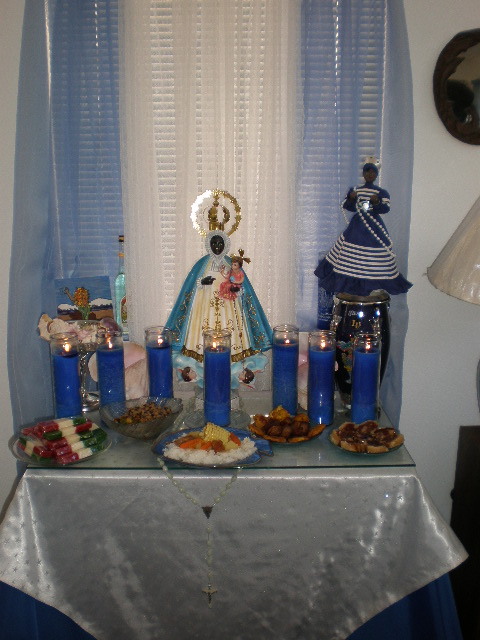
Feast Day for Yemaya/Yemoja/Iemanja Sept. 7, 2008 | Part 3 of 3
Posted by Jacqueline on Sep 10th, 2008 in Special Announcements | Comments Off on Feast Day for Yemaya/Yemoja/Iemanja Sept. 7, 2008 | Part 3 of 3In the last post, I talked about the various foods cooked and served to Yemaya (and our guests). I am now going to talk about setting up your altar.
Your traditional altar has either a framed photograph or statue of the image, whether it is in the form of a Catholic Saint or some other piece of art that holds their image. You may also worship in a more indigineous or authentic style, as in Yoruba, where you have the “sopera” or soup tureen-like covered jar with the implements of that particular Saint contained within. Since I have an actual statue from Spain of Yemaya, also known as the Virgen of Regla, I used it as the focal piece of my altar.
The dishes that we offered are from left to right: Mexican coconut candy for guests to take as they depart, fried okra and stewed black eyed peas, Pork Iyako (a farmer’s stew) on a bed of rice, fried pork chunks surrounded by fried plantains, and homemade coconut candy with melao (molasses).
Notice the corresponding drapery behind the statue and on the tabletop that matches the color related to the Saint. Yemaya’s colors are shades of blue and crystal clear white. To the left of the statue is a raised silver dish with various sea shells in it, a conch shell flanks each side of the statue, and to the right is a mini congo drum made by Carlos Santana to commemorate his album, “Supernatural” with a porcelain and cloth doll in the navy blue dress associated with Yemaya Okute (“She who cuts with a Knife”) that I just had to have when I found her in Sedona, Arizona, of all places.
As the day got later, we had more visitors, and more candles were brought to light, necessitating another table in front of the altar. A peaceful and happy time was had by all.

